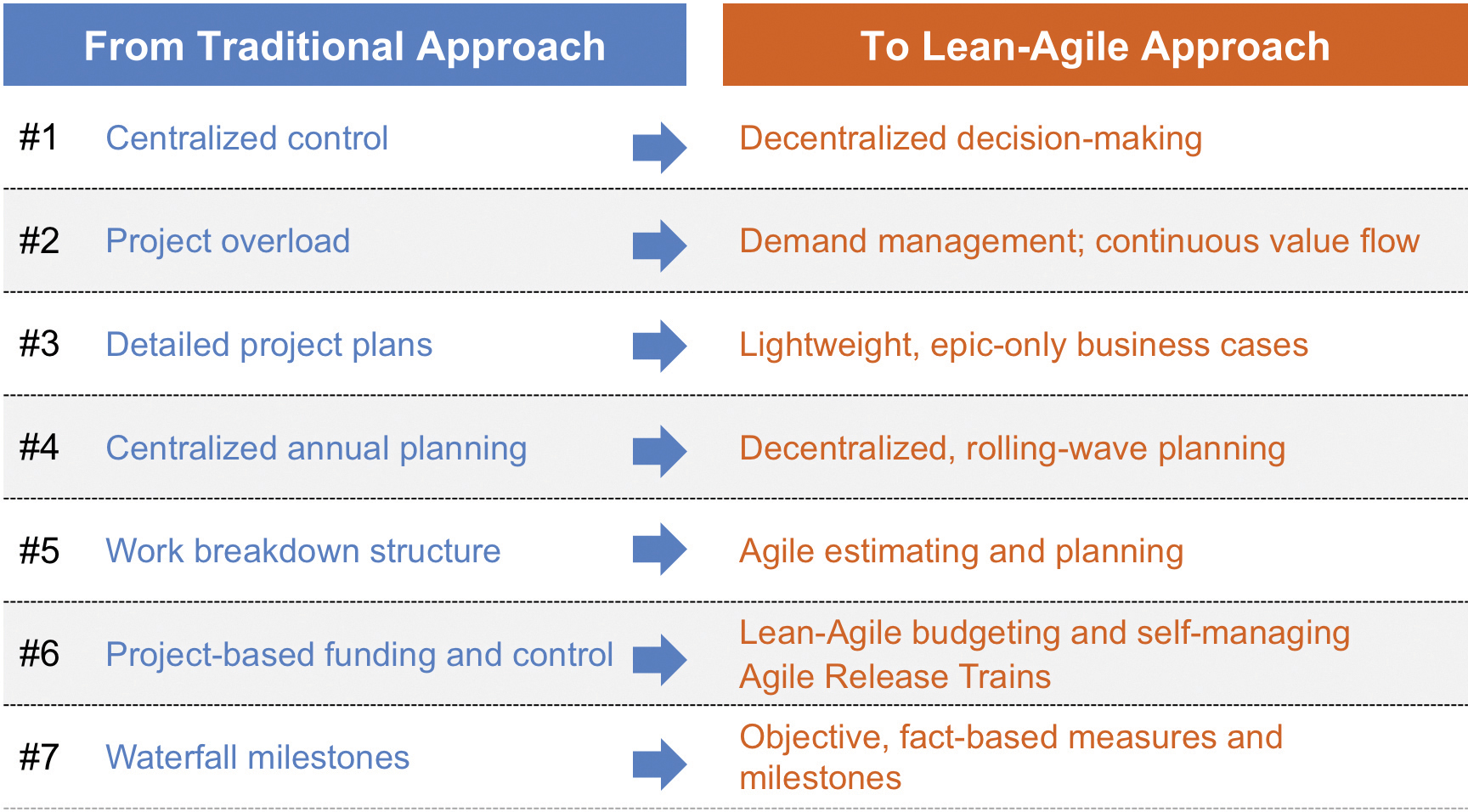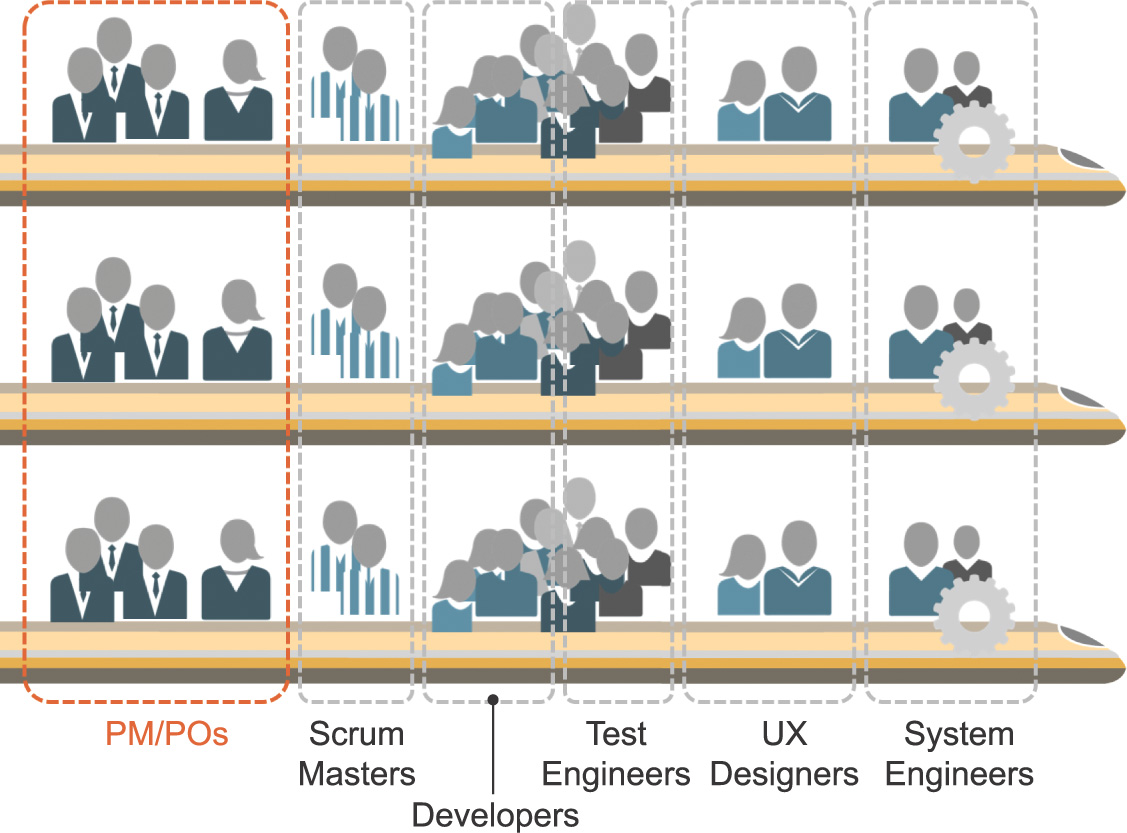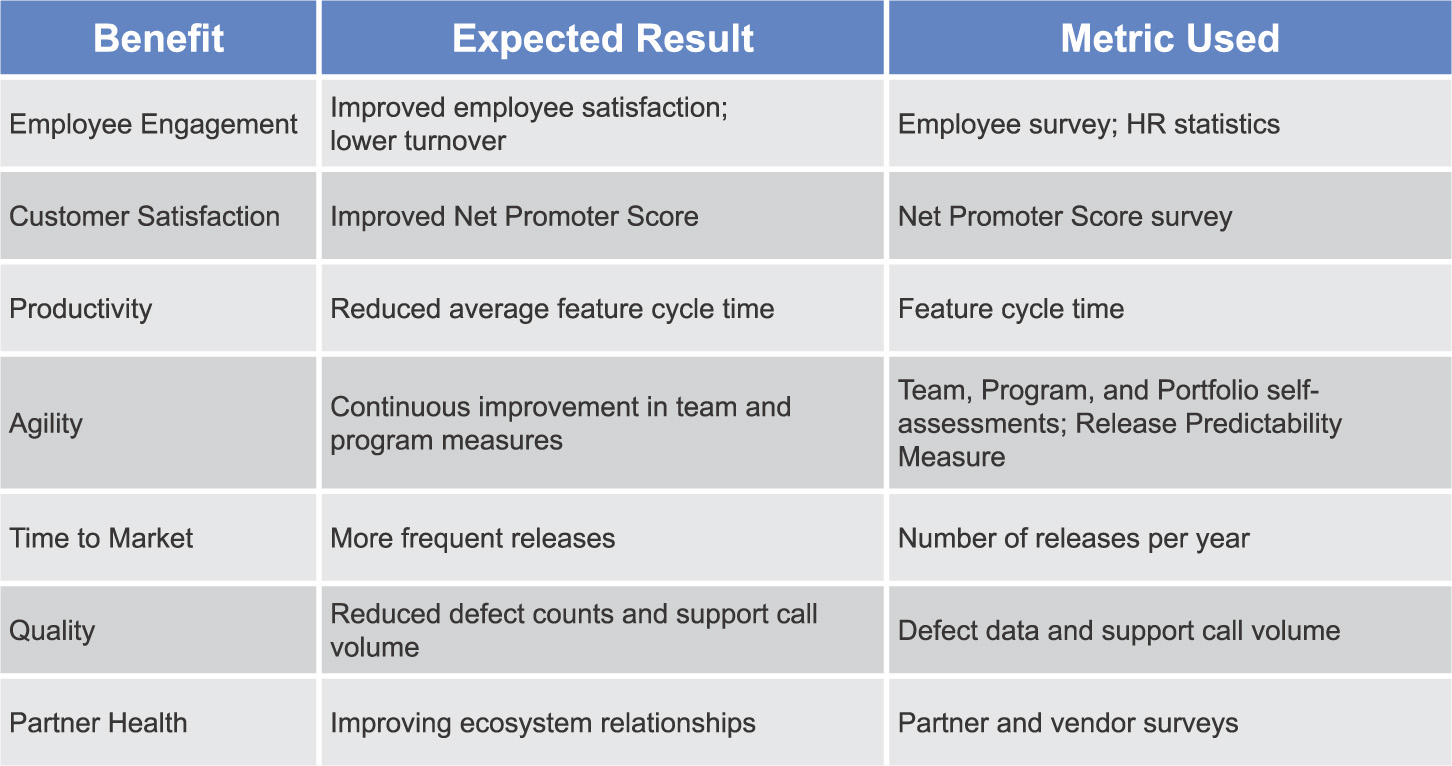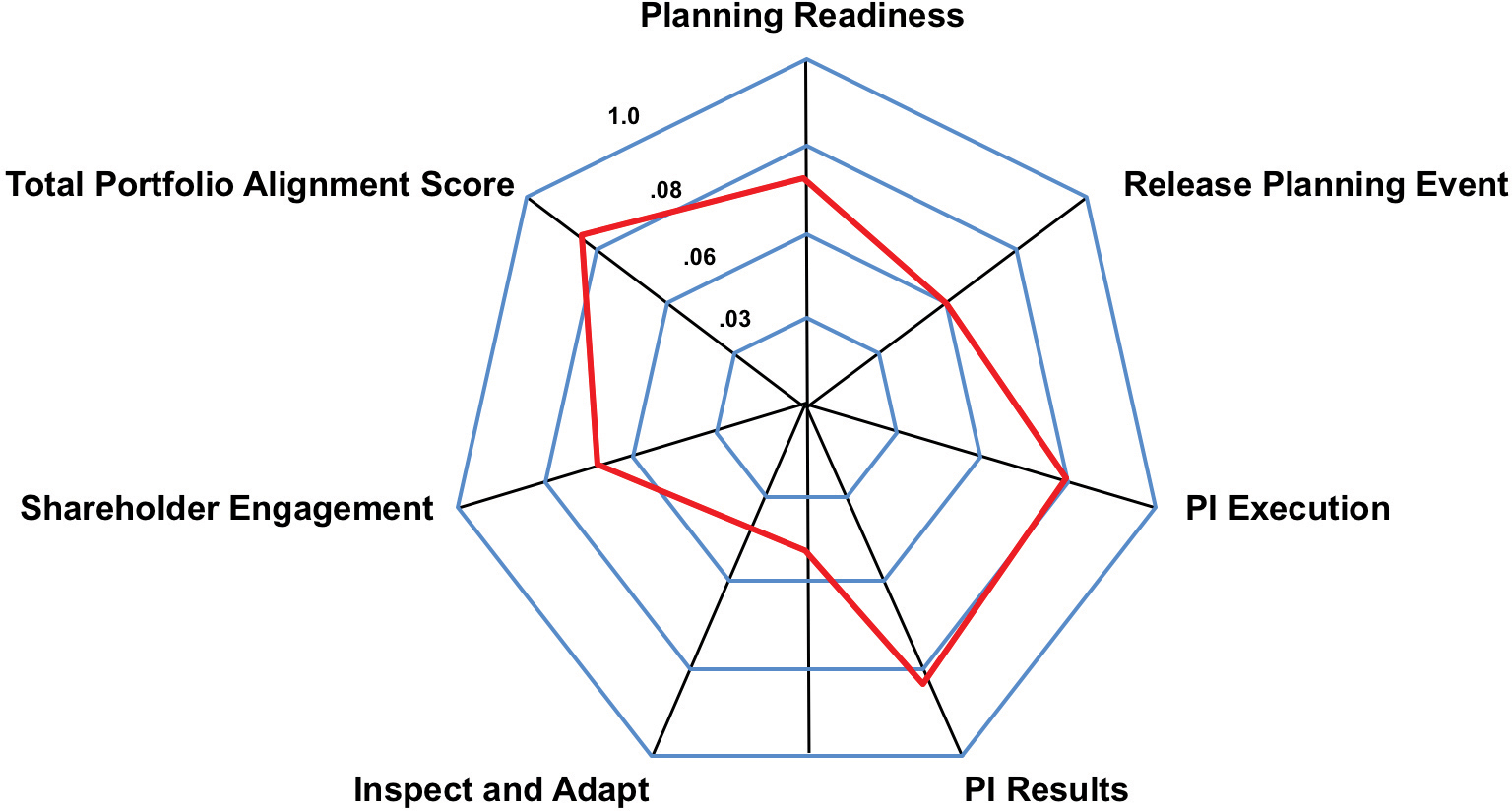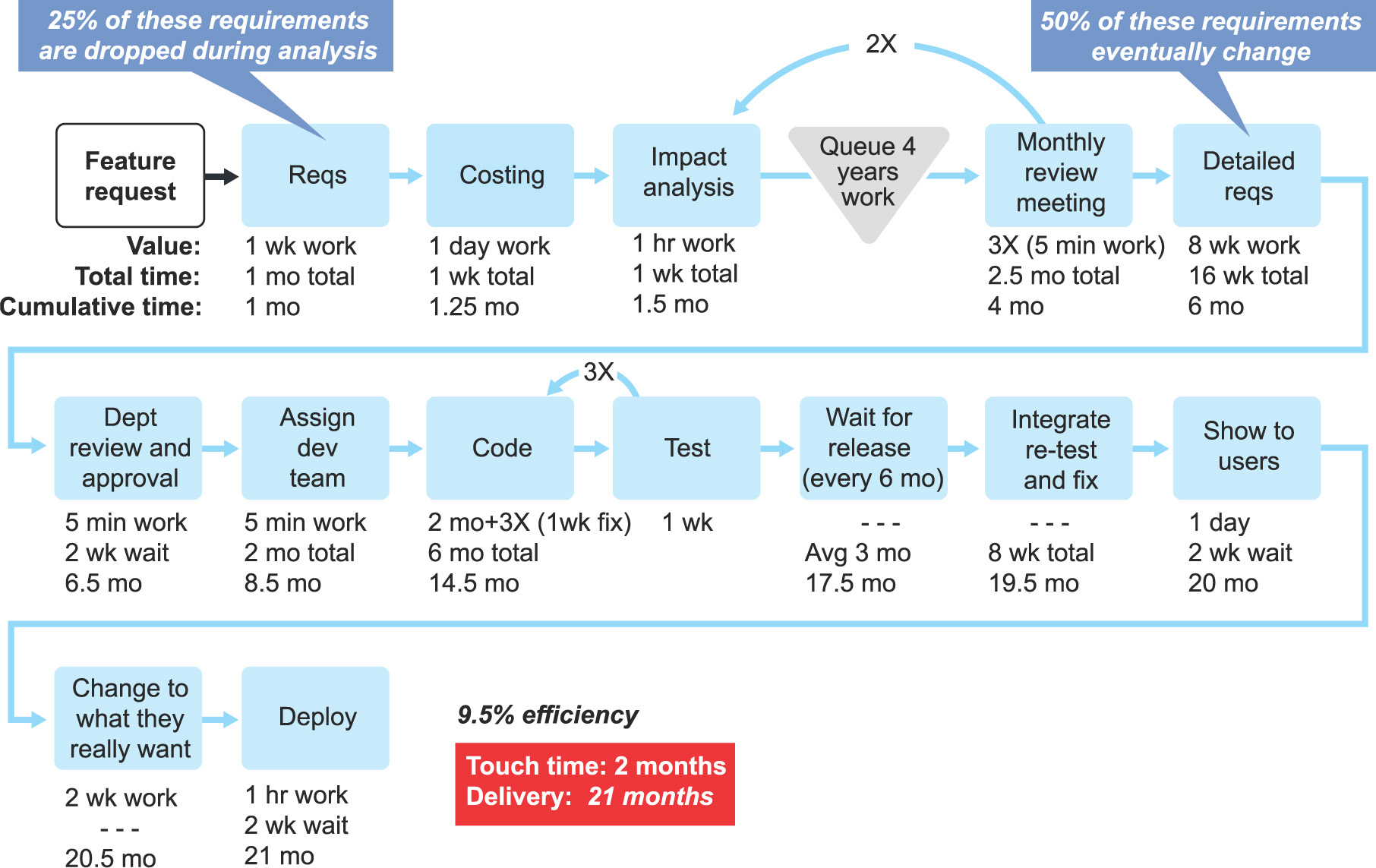18. Sustain and Improve
Excellent firms don’t believe in excellence—only in constant improvement and constant change.
—Tom Peters
Advance Organizational Maturity
Improve Agile Architecture and Technical Practices
Focus on DevOps and Continuous Delivery
Reduce Time to Market with Value Stream Mapping
Introduction
In the past three chapters, we described a pattern for the successful implementation of the Scaled Agile Framework (SAFe). One Agile Release Train (ART) at a time and one value stream at a time, the business will move to this new way of working. Most importantly, substantial business benefits will occur.
But even after the initial business benefits are in place, this initial state of Lean-Agile adoption is not the end of the journey. It’s just the next stage in the process of “relentless improvement.” Of course, that means continuous change, which can be a hard thing for an enterprise to grapple with. By now, however, the emerging Lean-Agile enterprise will have started to build a new operating model and culture, one for whom continuous improvement is the norm.
In this chapter, we’ll describe the next and ongoing steps, things the enterprise can do to continuously sustain and improve its business performance.
Advance Organizational Maturity
We’ll start with the mindset and culture of the organization by focusing on the following practices:
• Persisting the Lean-Agile mindset
• Lean-Agile Program Portfolio Management (PPM)
• Communities of Practice (CoPs)
• Advancing facilitation skills
Persisting the Lean-Agile Mindset
It continues right where it began, with leadership and the Lean-Agile mindset. Figure 18-1 illustrates the direct connection between leadership and relentless improvement. You can’t have one without the other.
Leaders provide a continuous sense of urgency for change and improvement and exhibit the same by their behavior. They also foster and support the other elements of sustain and improve, as described in the following sections.
Lean-Agile Program Portfolio Management
Nowhere is this Lean-Agile leadership more important than when addressing some of the legacy challenges of traditional Program Portfolio Management (PPM). In chapter 13, “Portfolio Level Overview,” we illustrated how these mindsets evolve (Figure 18-2) as part of implementing SAFe.
And under the mantra of “it is better to lead than follow,” the new, Lean-Agile Program Management Office (PMO) can take a lead role and thereby do the following:
• Lead the Lean-Agile transformation.
• Foster the Lean-Agile Center of Excellence (LACE) and other related CoPs.
• Apply objective milestones.
• Evolve leaner and more objective governance practices.
• Lead the move to Lean-Agile budgeting, forecasting, and capital expenses.
• Coach the ARTs in effective SAFe program delivery practices.
• Foster Agile contracts.
Lean-Agile Center of Excellence
We’ve described the LACE to this point as a focus on the transitional role of this change team, an engine of the “sufficiently powerful coalition for change.” As such, it is primarily involved in implementing the new way of working within the organization. However, this change is not a one-time event; rather, the focus on Lean is to continually lower costs, reduce time to market, and increase the velocity of value delivery. There is no end. Therefore, the LACE often becomes a semipermanent body, a true center for excellence. This group understands the new way of working and continually advances its individual skills and uses its expertise to facilitate and foster the leaner, more Agile ways of working. But the LACE is only one such element of the coalition. To really sustain and improve, we need additional help.
Communities of Practice
As we have described throughout this book, SAFe organizes people with different skills around a value stream. However, organizing this way has an unintended consequence: It can limit the opportunities to share knowledge and learn new skills with other people in the same role. That’s one of the advantages of the functional organization that SAFe leaves behind. After all, we have to decide what to optimize for, and we can’t have it both ways.
CoPs help overcome this limitation by organizing people around a subject domain, work roles, or other areas of interest. Community members regularly interact with other like-minded practitioners to share knowledge, experiences, and practices. This gives practitioners with common interests the opportunity to collaborate and share knowledge outside of their team or program. For example, Scrum Masters from different Agile teams or trains may form a CoP to exchange best facilitation practices and experiences in building high-performing Agile teams. Product Owners may form a CoP to improve how they write user stories and prioritize their backlog.
Figure 18-3 illustrates an example of how members of different Agile teams may form a role-based CoP.
CoPs form and disband based on current need and context. For example, an automated testing CoP could be comprised of test engineers and developers interested in advancing their skills. An architecture and design CoP might foster the adoption of practices such as emergent design, intentional architecture, and user experience. It could also support building and maintaining the architecture of a solution, foster designing for testability and deployment readiness, retire old platforms, and more. Still others may be formed around Agile coaching, DevOps, and continuous delivery.
Advancing Facilitation Skills
Effective SAFe is built on effective Agile teams. We’ve already highlighted the critical role that the Scrum Master plays in helping develop effective Agile teams. Once Scrum Masters become adept in handling their basic responsibilities, many will be ready to take the next step to enhance and cultivate their skills.
This can provide the spark that can help drive higher team performance and simultaneously provide personal and career growth opportunities for this critical role.
Many benefit by taking a two-day SAFe Advanced Scrum Master course. It prepares current Scrum Masters for their leadership role in facilitating Agile team, program, and enterprise success in the larger and more mature SAFe implementation. The course covers facilitation of cross-team interactions in support of the program execution and relentless improvement. It enhances the Scrum paradigm with the following:
• An introduction to scalable engineering and DevOps pipeline practices
• The application of kanban to facilitate the flow of value
• Support of interactions with architects, product management, and other critical stakeholders
The course offers actionable tools for building high-performing teams and explores practical ways of addressing Agile and Scrum anti-patterns in the enterprise.
In a similar fashion, with equivalent trainings and CoPs, Release Train Engineers can improve their skills as Agile program managers, team coaches, and program-level facilitators.
Implement Agile HR Practices
“Respect for people” is a pillar of the House of Lean. It is people who build these critical systems we all depend on. These knowledge workers come to work intrinsically motivated to build high-quality, innovative systems. Given the importance of their work, management’s challenge is to provide an environment in which they can prosper and do their best work.
While SAFe provides many of the values and practices of that environment, it also puts extreme pressure on traditional Human Resources (HR) practices. This compels enterprises to embrace a new, Lean-Agile HR perspective to accommodate the modern knowledge worker. There are six major themes of this new dynamic.
1. Embrace a new talent contract, one that explicitly acknowledges the need for value, autonomy, and empowerment.
2. Foster continuous engagement, to both the business and technical mission.
3. Hire people for Agile attitude, team orientation, and cultural fit.
4. Eliminate annual performance reviews; replace with continuous, iterative performance feedback and evaluation.
5. Establish compensation policies that effectively compensate for their efforts. Eliminate destructive individual financial incentives. “Take the issue of money off the table.”
6. Support meaningful, impactful, and continuous learning and growth.
Measure and Take Action
We haven’t focused much on measures in this book, other than the continued presence, evolution, and evaluation of working systems. But you can’t knowingly improve what you can’t measure, so in this section we’ll take a quick look at a few of the many opportunities to measure and improve.
Inspect and Adapt
ARTs are created for a single reason: to gather the right people together and cultivate an environment in which they can build the best possible systems in the shortest possible time. To that end, it’s hard to overemphasize the importance of ART (and value stream) Inspect and Adapt (I&A). That’s why it is the entire subject of chapter 9, “Inspect and Adapt.”
These are the cornerstone events of program execution and improvement. And unlike simpler forms of retrospectives, these bring the key stakeholders—the people who can change the systems in which they and others work—into an objective demonstration, measurement, and structured root-cause analysis and corrective action workshop. Here, they create and execute the changes to systems and processes needed to continually increase delivery velocity.
Leaders must actively encourage and participate in I&A problem-solving. This “closes the loop” on the Program Increment (PI) learning cycles and is the basis for continuously improving enterprise performance.
Lean Metrics
With its timeboxes, work physics (stories and features), fast feedback, and transparency, Lean-Agile development is inherently more measurable than prior methods. (For more, see scaledagileframework.com/metrics.) But metrics are a double-edged sword; people tend to focus on the measures, which are, at best, a proxy for the desired outcomes. However, without measurement, progress cannot really be certain. And since there is an investment required to fund any change, some measures must be put in place to assure a commensurate return.
In the spirit of the “simplest thing that can possibly work,” we provide Figure 18-4, a set of seven measures that have been used to effectively measure SAFe transformations of significant size.
Enhance Performance with SAFe Self-Assessments
But when it comes to people, people don’t generally like to be measured. After all, a person can be evaluated only by being compared to some other person. And only the person at the top can feel good about that outcome.
Further, many measures traditionally applied to the development process, and its people, are now obsolete. What’s more, being measured by others is anathema to empowered, self-managing Agile thinking.
Instead, we suggest that teams self-assess against agreed-to Agile values. This is not new. The Scrum community has promoted various team-level self-assessments for years. To our larger purpose, SAFe provides a set of self-assessment worksheets for each of the team, program, value stream, and portfolio levels. Figure 18-5 shows an example of a typical radar chart for an ART self-assessment.
These can be used periodically to help teams advance their team, program, value stream, and, ultimately, portfolio performance.
Improve Agile Architecture and Technical Practices
Agile Architecture
Agile or not, it’s impossible to build significant world-class systems without some degree of intentional architecture. However, the Big Design Up Front (BDUF) practices of waterfall development are no longer relevant.
That means solution architecture must be built in concert with building the solution. This includes the creation of new architectural underpinnings (architectural runway) and practices for incrementally evolving legacy systems into the new platforms of choice. (In other words, yes, we do have to change the engine while we are driving to the destination.)
For this purpose, it’s effective to create an Agile architecture CoP and/or a series of workshops. This allows System and Enterprise Architects to come together to define and learn the leaner and more incremental approaches to establishing and evolving solution architecture and to continuously advance their Agile architectural skills and craft. Topics addressed in this forum can include the following:
• Review and adopt SAFe’s eight principles of Agile architecture.2
2. http://www.scaledagileframework.com/agile-architecture
• Identify enabler epics and capabilities necessary to evolve the solution architecture.
• Establish the flow of enabler epics and features in the relevant kanban systems.
• Identify methods of splitting architectural epics into enabler capabilities and features for incremental implementation.
• Establish the decision-making framework and policies for architectural governance and capacity allocation.
• Identify relevant Nonfunctional Requirements (NFRs).
In many enterprises, such workshops are run on the PI cadence, often aligned with the Innovation and Planning iteration. This conveniently supports the availability of development teams for fast feedback spikes to help establish the technical viability of various design alternatives. Such timing also supports the pressing need to prepare architectural concepts and models for review in the upcoming PI planning session.
Agile Technical Practices
We’ve observed that within the first year or so of adoption, teams can quickly reach an apparent velocity limit by implementing only the basic role and team project management practices. After that, further improvements in velocity and quality can occur through effective implementation of Agile technical practices3 (for example, built-in quality software practices, including continuous integration, test-first, and test automation). Mastering these takes an additional investment of focus and time, typically augmented by outside experts who have applied these practices in other contexts. Time must be allocated for this new learning. Again, the Innovation and Planning (IP) iteration can often provide the dedicated time needed for continuing education and practice in support of these new approaches.
3. See http://scaledagileframework.com/built-in-quality for a complete list of built-in quality practices.
In addition, companies building really large and/or high assurance systems need to focus on evolving fixed and variable solution intent and maintenance of architectural and other models that show how the system works. Implementing and advancing model-based systems engineering can provide a level of automation to develop and maintain these important artifacts.
Focus on DevOps and Continuous Delivery
Once Agile Release Trains are launched and value streams begin to better operate, that will increase visibility into the next set of bottlenecks and impediments to improved economics via more incremental delivery. Often, “leaning out” the development cycle just moves the bottleneck further down the value stream toward deployment. Since DevOps is integral to the value stream, SAFe ARTs include deployment personnel.
In order to establish an effective deployment pipeline—a continuous flow of new value from development to and through deployment—six specific practices are recommended as follows:
1. Build and maintain a production-equivalent staging environment
2. Maintain development and test environments to better match production
3. Deploy to staging every iteration; deploy to production frequently
4. Put everything under version control
5. Start creating the ability to automatically build environments
6. Start automating the actual deployment process
Another important aspect of assuring a continuous and reliable operating environment is the ability to automatically report system health and status. Development teams build application telemetry into the system to reduce the overhead and friction of manual monitoring and collection of data.
In addition, DevOps and continuous delivery provide faster feedback for ideation, design, implementation, and release. In other words, DevOps helps not just to deliver fast but also makes sure teams are delivering the right thing.
And finally, the impact on application architecture should not be underestimated. Long term, the continuous delivery pipeline requires systems that were designed—at least in part—with continuous delivery in mind. However, these practices involve a mindset shift and environment enablement, which includes things such as tooling and infrastructure for automation, and application telemetry. The shift in thinking requires strong leadership from managers and subject-matter experts who have the authority to create the environment for continuous value delivery. CoPs can also play a leading role.
Reduce Time to Market with Value Stream Mapping
The value stream is the most important organizational construct in SAFe. “Taking a systems view of value delivery” means understanding all the steps from ideation and feature approval to development, through deployment, all the way to release. The total average time for all these steps, including the delay times, is the average time to market for any new feature. This gives us one more, important tool in our toolbox. That is the process of value stream mapping, an analytical process teams can use to first understand, and then improve, time to market.
Figure 18-6 illustrates an example value stream map for a software company.4
4. Mary Poppendieck and Tom Poppendieck, Implementing Lean Software Development: From Concept to Cash (Addison-Wesley, 2006).
It is clear that this company’s current process is complex and slow. Total time efficiency is such that a feature that takes two months to develop takes twenty-one months to get to market! Most all the time is spent waiting for the next step. (When a process runs at 100 percent utilization, every new thing has to wait for service.) Clearly there is substantial room for improvement.
As the SAFe enterprise matures its value stream thinking, an important improvement step is to map the value stream and make improvements. The steps are as follows:
• Map the current state by identifying all the steps, value-added times, handoffs, and delays, from receipt of customer request to release.
• Identify the largest sources of delays and handoffs as the feature moves through the system.
• Pick the biggest delay. Perform root-cause analysis. Create improvement backlog items to reduce the delay. Reduce batch sizes wherever possible.
• Implement the new improvement backlog items.
• Measure again, and repeat the process.
With this process, the maturing Lean enterprise has a systematic way to directly, aggressively, and continuously improve time to market, to its own business benefit.
Summary
In this chapter, we discussed the next and ongoing steps, things the enterprise can do to continuously sustain and improve its business performance.
The key takeaways from this chapter are as follows:
• Relentless improvement is a pillar of the SAFe House of Lean. Leaders provide a continuous sense of urgency for change and improvement and exhibit the same by their behavior.
• Nowhere is Lean-Agile leadership more important than when addressing some of the legacy challenges of traditional PPM.
• The LACE often becomes a semipermanent body, a true center for excellence. This group uses its advancing expertise to foster continuously leaner and more Agile ways of working.
• CoPs help overcome the limitation of organizing people around value streams. Community members regularly interact with other like-minded practitioners to share knowledge, experiences, and practices.
• Scrum Masters and Release Train Engineers play a particularly critical role in the culture of moving from centralized command and control to a distributed, facilitative, servant leadership culture. Advanced training is available for these and other roles.
• For some enterprises, Agile HR differs radically from the traditional approach. Agile HR establishes a new talent contract, one that fosters continuous engagement, empowerment, and autonomy, and eliminates demotivating policies and procedures.
• I&A is the cornerstone of relentless improvement. In addition, SAFe provides a variety of possible operating metrics, as well as self-assessment worksheets for each of the team, program, value stream, and portfolio levels.
• To accelerate delivery, teams adopt Agile architecture as well as various software and system technical and quality practices. These provide the foundation for fast iterations and efficient regression testing.
• Implementing DevOps and continuous delivery helps identify and eliminate bottlenecks and facilitates the goal of optimum economics via a continuum of fast, efficient, and high-quality releases.
• Value stream mapping provides a systematic way for a maturing lean enterprise to continuously improve its time to market.


